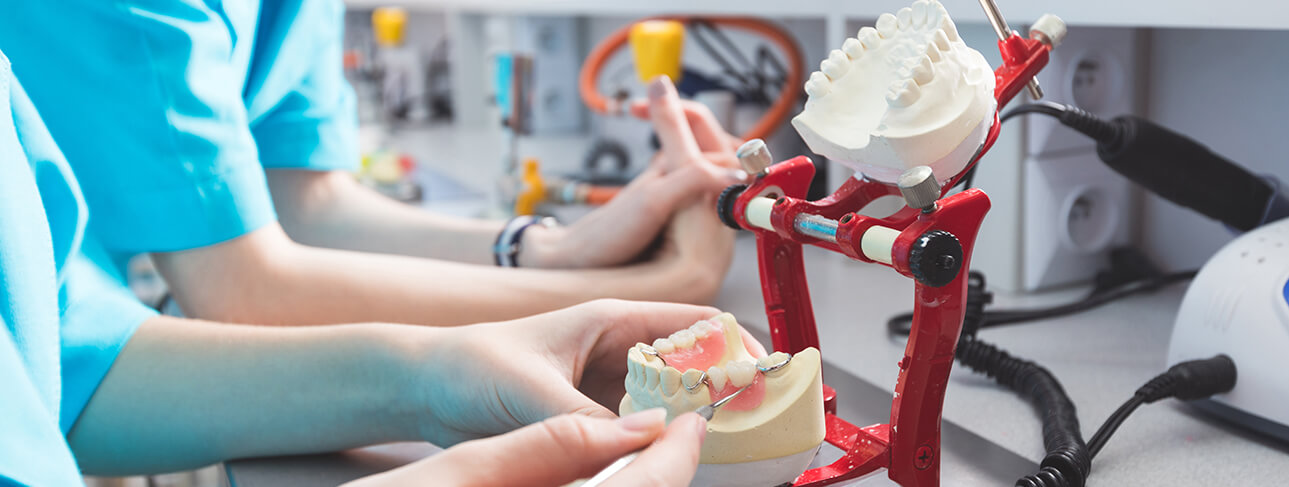
About Pre-prosthetic Surgery
Pre-prosthetic oral and maxillofacial surgery refers to a range of procedures that may be necessary to prepare a patient and their jaws for full or partial dentures (prosthetics). These are fairly minor procedures that may be done in the office, normally under sedation, in a timely and efficient manner.
When Should Pre-prosthetic Surgery Be Performed?
These procedures are best performed either at the same time as extraction of teeth or at least 6 weeks prior to the impression and formation stage of the denture process. The surgical area will require at least 6 weeks to heal, yielding a more accurate result for the dentures than if fabrication is commenced earlier. More accurately, full bone healing following surgery will not be achieved until approximately 12 weeks following surgery.
Types of Pre-prosthetic Surgery
- Tori Reduction
- Tuberosity Reduction
- Alveoplasty
- Vestibuloplasty
- Frenectomy
Palatal and Mandibular Tori Reduction
In general, tori are completely harmless, excessively large bone formations. These typically occur in two specific areas, the roof of the mouth (hard palate), referred to as torus palatinus, or underneath the tongue on the lower jawbone, referred to as lingual tori.
These bone formations occur in approximately 9% of the population. Tori are often of no consequence with the exception of people who frequently traumatize the area or for patients who are planning to have a dental prosthesis, such as dentures, to replace missing teeth. The prostheses would significantly traumatize the areas of the bone where the tori are formed and lead to poor prosthetic retention. Tori reduction is normally done in the office, typically under sedation.
Procedure:
- Minor incision in the gum tissue is made to expose the tori area
- Bone formation is reduced and smoothed with specialized instruments, creating a smooth and fluid form to the upper and lower jaws of interest
- Area is closed with sutures
Tuberosity Reduction
The maxillary tuberosity is an area of thick gum tissue often characterized by widened, tall bone growth in the back of the upper jaw behind the area of the third molar on both sides. This area is significant for patients who are planning to have upper jaw prosthesis fabrication for two reasons. The maxillary tuberosity is an important area that helps keep the prosthesis in place, and because it is often an area of soft tissue or bone overgrowth, it can lead to irregularity in the upper jaw contour in this area.
Tuberosity reduction may involve both the reduction of the excess gum tissue and any excess bone that exists in the area, and each case is unique in the specific amount and location of reduction necessary. Generally, this procedure is done in the office under sedation.
Procedure:
- Incision is made in the area of excess tissue
- Excessive soft tissue and/or bone is removed until the appropriate contour is achieved
- Area is closed with sutures
Alveoplasty
The upper and lower jaw bones are composed of two different types of bone, the alveolar bone which envelopes the teeth, and the basal bone which creates a dense base on which the alveolar bone rests. Many times following tooth extraction, the alveolar bone leaves very irregular areas during the healing process. These irregular areas may cause significant soreness or instability for any prosthesis. Thus, before prosthesis fabrication, it is best to address any areas of poorly or irregularly healed alveolar bone, a procedure known as alveoplasty.
Alveoplasty may be very minor and localized to one small area, or it may be more generalized. The degree of alveoplasty required will often determine the type of anesthesia best suited for the procedure, though Dr. Tomlinson recommends that any cases beyond very minor reduction consider sedation. The procedure is readily conducted in the office.
Procedure:
- Incision is made in the gum tissue over the irregular area(s)
- Instruments are then used to appropriately smooth and re-contour the bone in the area to best suit the planned prosthesis
- Area is closed with sutures
Vestibuloplasty
Vestibuloplasty is a procedure that is almost exclusively performed in the lower jaw, and normally only in the front part of the lower jaw. For patients who have been missing teeth for a period of time, the body responds by breaking down and resorbing the bone in the areas where teeth are missing. If this occurs in the front area of the lower jaw, the atrophy and resorption can cause the height of the remaining bone and gum tissue to be unable to support a prosthesis.
In these cases, a vestibuloplasty procedure may be performed to increase the functional height by lowering the muscle attachments of the lower lip to the appropriate area of the lower jaw. Depending upon the scale of vestibuloplasty required, this procedure may be performed in the office under sedation or in the operating room under general anesthesia. Dr. Tomlinson will discuss these details with you during your consultation appointment.
Frenectomy
Frenum refers to a normal anatomical area of muscle attachment that occurs between the upper and lower lips to the respective upper and lower jaws, and the underside of the tongue to the back of the lower jaw, the lingual frenum. Frenums are unique in size to every individual. The lingual frenum is the collection of tissue underneath the tongue that leads to ankyloglossia or “tongue-tie,” a condition that restricts the movement of the tip of the tongue due to short or oversized lingual frenum.
Frenectomy is a fairly straightforward procedure where the excessive frenum tissue is cut, and in some cases removed. It is performed to achieve a more appropriate movement and function of the surrounding tissues. This procedure is readily performed in the office, typically under sedation.
Problems Caused by an Excessively Large Frenum:
- Inhibits appropriate tongue movement
- Speech impairment
- Eating problems
- Frequent trauma
- Negatively impacts dental development and the appropriate fabrication of a prosthesis
